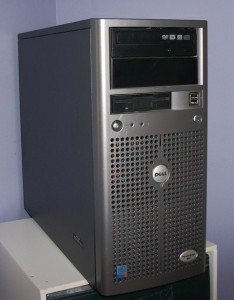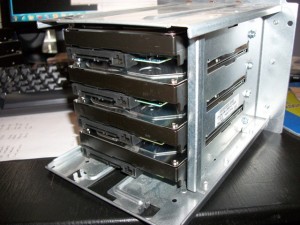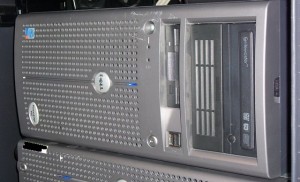PART 3: Storage I – NAS
I haven’t written about my homelab project in some time. So I figured now would be a good time to write about my storage setup – since it is currently undergoing an upgrade. For this part, I will focus on how I am upgrading my current NAS unit.
I am currently using a Dell PowerEdge 2850 running OpenFiler v2.3 with 1.3TB (6x300G: RAID5) and a Dell PowerVault 745N Win2003 Storage Server 1TB NAS (4x250G: RAID5). The PE2850 serves a dual purpose – it houses VMs for my virtual environment and additional iSCSI “drives” for the PV745N. I am wanting to grow and replace my PV745N as it is close to full. In addition, I want to cut back on the amount of heat I generate and the power draw from the PE2850.

I knew that I wanted to have at least 4TB of storage when all was said and done. Several days was spent researching my options. I looked at a number of 4TB NAS units to replace the PV745N. The NetGear ReadyNAS NV+ (http://www.newegg.com/Product/Product.aspx?Item=N82E16822122010) was definitely in consideration for my plans. I liked that it could allow me to upgrade my drives down the road using the X-RAID function without having to do a forklift upgrade. (Eventually, this may show up under my tree – *hint, hint Santa*.)
Performance is not that big of an issue as this is my homelab. Therefore, I’m not looking for insane IOPs, nor super fast anything. Most of my data is static, however, I want plenty of room for media, backups, etc.

Instead of spending money on a new device, I decided that I would just recycle a machine I had lying around. I pulled out a Dell PowerEdge 800 and added a few components. I removed the existing 80GB SATA Drive and replaced it with (4) 1TB Hitachi 7200RPM SATA II Drives. I wanted to connect these new drives to a decent hardware RAID card, but unfortunately, I couldn’t afford to purchase one right now. From my choices at my local MicroCenter, I did some research and picked up a HighPoint RocketRAID 1740 PCI Card. It wasn’t until AFTER I got the card home and installed, that I discovered it did software RAID instead of Hardware RAID. (Phooey!) Had I of known this previous to the purchase, I would have stuck to the onboard SATA ports and let the OS do software RAID.
Once I had the gear together, I started to compare what OS to run on the machine. I looked at OpenFiler v.2.99, FreeNAS 8.0, ubuntu 10+, and Windows Server Solutions. I have been running Windows Home Server as a virtual machine for a little while. One thing I like about it is the easy built-in backup solution. As most IT guys know, the reason why we choose some products over others has little to do with advanced feature sets, purchase discounts, etc. Usually, we look at what we need, versus what we want to teach our user-base. In my case, this storage unit was going to be replacing the PV745N NAS unit I was using for media storage (movies, mp3s, and photos). For that reason, I did not want to have to retrain my user-base (ie., my wife) on how to connect to her “shared drive” to get her music, pics, etc. As well, I did not want to have some elaborate method that I knew she would not use for means of backups. My choice was now narrowed to Windows Home Server. And I stuck to what I was using previously. 🙂
(I realized AFTER I installed Windows Home Server, that a newer version (WHS 2011) was released in April. I will have to check and see if I want to upgrade to it.)
The before and after comparison:
BEFORE
“Recycle”
Dell PowerEdge 800
Intel P4 2.8Ghz 800FSB CPU
1GB DDR2 RAM
(1) 80GB Matrox 5400RPM SATA I HD

AFTER
“She-Hulk”
Dell PowerEdge 800
Intel P4 3.06Ghz 533FSB CPU
4GB DDR2 RAM
(1) 160GB Seagate 7200RPM SATA II HD
(4) Hitachi 7200RPM 1TB SATA II HDs
HighPoint RocketRAID 1740 PCI RAID Controller
I’m sure you are wondering why the change in some of the parts. I changed the CPU as the replacement is 64bit capable. I added more RAM (4GB Total – as this was the max for the board). I also added an additional HD. This drive is for the OS and other non-essential data. Now known as “She-Hulk”, the PE800 was brought to life. She purrs and runs just fine. I wonder if I should remove her shell and paint her green. That would be interesting.
PART 3: Storage II will be coming soon. I have plans for the PV745N.


I have a question, I just bought one of these and was wondering how you installed the drives in the hard drive caddies in the drive bay? I was thinking about buying a 3rd parity backplane or something but it idk it doesn’t need to be hot swap-able. It looks like you just took the SCSI backplane off?
For the Dell PE800, the drive caddy didn’t have a SCSI backplane attached to it. While having four SATA ports on the motherboard, it didn’t have a RAID controller. So I installed a RAID controller and used it instead of the existing SATA ports on the motherboard. The built-in drive caddy can hold four 3.5 inch drives. While there are two 5.25 drive bays, I choose to use one for the CD-Rom, and the other holds the OS Drive (IDE).
As for the Dell PE2850, I’m using the built-in RAID Controller (I believe a PERC 4) with the built-in backplane for the storage.
OK,My PE800 came with a SCSI backplane and 64MB SCSI 320 controller. I’m not going to attempt to buy hard drives (SATA or SCSI) at this moment time (because of the flooding) . Playing around in the BIOS, I found a setting to change the SATA from ATA mode to RAID mode then it will install the SATA RAID bios for the built-in controller. I think I’m going to buy 4 western digital 1-2TB black or blue version when the price comes down. I’m doing this flavor of Ubuntu called Mythbutnu,that has a frontend and a backend. With the PE800 as the backend with all the little things like samba for file sharing and a DVR feature.
I’m dying to know the plans for the PV745N. I have the chance to pick one up for next to nothing. Want to know if it’ll run 3x2tb sataii in RAID5 on whs2011 to “replace” the whs11 vm i have on a poweredge 2900iii for what im using it for the pe is way overkill…curious to know what ‘good’ options work with the PV745N. Thanks!
I looked into upgrading the drives in my 745N. Unfortunately, the max size you will be able to put in it is 500G drives for a 2TB NAS. This is because of the 2TB limit the RAID card has. You could replace the RAID card with another that could allow you to go larger, but I had a very hard time finding one in my budget. Instead, what I wound up doing was upgrading the BIOS using a PowerEdge 750 bios. Now the machine thinks it’s a PowerEdge 750 and I don’t have the limitations the 745N bios had. I then installed FreeNAS 0.7+ on it and made it into a SABNZBD/SickBeard/Couch Potato Server. I should sit down and write up exactly what I did to repurpose this machine so that others could follow along.